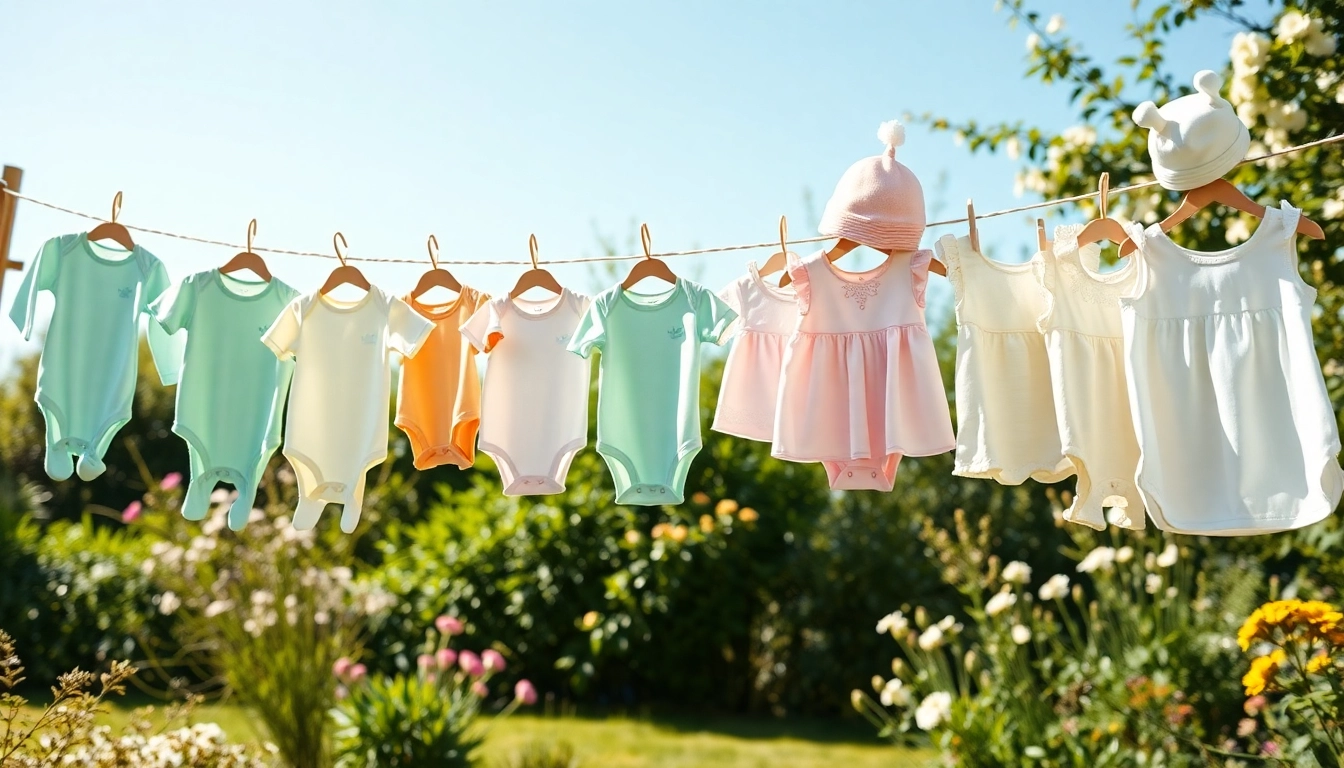Understanding Baby Clothes: Essentials and Beyond
Choosing the right Baby clothes can be a delightful experience for new parents, yet it also comes with its set of challenges. With a myriad of options available in different styles, fabrics, and fits, parents must navigate their choices carefully to ensure their baby’s comfort, safety, and style. This guide delves into the essential factors to consider when selecting baby clothes, ensuring that both functionality and aesthetics are prioritized.
Importance of Quality in Baby Clothes
Quality is paramount when it comes to baby clothing. Infants have delicate skin, making them more susceptible to irritation and allergic reactions. High-quality baby clothes are typically crafted from soft, breathable fabrics that minimize discomfort and allow for easy movement.
Moreover, quality material can withstand frequent washing, maintaining its shape and color over time. Parents should look for items that are durable yet gentle on the skin. Labels that emphasize organic or hypoallergenic materials are often beneficial for babies with sensitive skin.
Different Types of Baby Clothes
From onesies to booties, the range of baby clothing is extensive. Understanding the different types will help parents outfit their little ones appropriately for various situations:
- Onesies: A staple in any baby wardrobe, onesies are versatile, ensuring comfort and ease when dressing.
- Sleepers: Perfect for nighttime, these often feature built-in feet and zippers for easy diaper changes, keeping babies warm and cozy.
- Pants and Tops: As babies grow, separates can provide more layering options. Choose elastic waistbands for flexibility.
- Outerwear: Jackets and snowsuits are essential for colder climates, ensuring babies stay warm without sacrificing comfort.
- Accessories: Hats, mittens, and booties can help regulate body temperature, vital for infants who cannot maintain warmth on their own.
Choosing the Right Fabrics for Baby Clothes
The fabric of baby clothes plays a crucial role in comfort and health. Opting for natural fibers such as cotton is often recommended due to their softness and breathability. Cotton allows for air circulation, reducing the risk of overheating. On the other hand, synthetic materials may not be as breathable and can irritate sensitive skin.
When selecting fabrics, consider the following:
- Organic Cotton: Free from harmful chemicals, organic cotton is an excellent choice for eco-conscious parents.
- Bamboo Fabric: Known for its natural antibacterial properties, bamboo fabric is soft and hypoallergenic.
- Wool: Great for colder weather, wool is warm yet breathable, making it ideal for layering.
Seasonal Baby Clothes: Dressing for Every Weather
Seasonal changes mean different fashion choices for babies. Being prepared for each season with appropriate attire ensures comfort and practicality.
Summer Styles: Lightweight and Breathable Baby Clothes
Summer calls for lightweight and breathable fabrics that allow babies to stay cool. Look for short-sleeved onesies, lightweight dresses, and cotton shorts. Light colors can reflect sunlight, helping to keep your baby comfortable.
When selecting summer clothing, consider sun protection as well. Hats with brims and long-sleeved shirts made of breathable fabric can offer essential protection from UV rays without overheating.
Winter Wardrobe: Warm and Cozy Layers for Babies
Winter dressing requires a careful balance of warmth and mobility. Layering is key; start with a soft base layer, followed by an insulative layer, and finish with an outer layer that protects against wind and moisture. Snowsuits and thick booties are must-haves.
For indoors, cozy fleece or wool sets can keep babies warm while not restricting movement during playtime.
Transitional Outfits: Adapting Baby Clothes for Changing Seasons
Spring and autumn often bring fluctuating temperatures, making transitional outfits necessary. Layering becomes essential; for example, pairing a long-sleeve shirt with short overalls can serve dual purposes, offering warmth if it’s chilly and allowing ventilation if the temperature rises.
Lightweight jackets or cardigans can provide an additional layer that is easy to remove as needed. Always consider layering options to accommodate changing weather conditions throughout the day.
Practical Tips for Buying Baby Clothes
Shopping for baby clothes can be overwhelming, given the sheer variety of options available. Here are several practical tips to help guide the purchasing process:
Budgeting for Baby Clothes: Smart Shopping Strategies
Setting a budget is crucial when preparing to purchase baby clothes. While quality matters, avoiding overspending is also essential. Consider the following strategies:
- Sales and Discounts: Take advantage of seasonal sales or clearance events to stock up on essentials.
- Second-Hand Clothing: Gently used clothing from thrift shops or online marketplaces can significantly reduce expenses.
- Capsule Wardrobe: Investing in a few key pieces that can mix and match can provide enough variety while keeping costs down.
Size Considerations: Ensuring Comfort and Fit in Baby Clothes
Wearing the right size is vital for your baby’s comfort and safety. Babies grow rapidly, so sizing can be tricky. Always refer to the size charts provided by the manufacturer and consider the following:
- Size Up: If in doubt, choosing a size up can offer room for growth, ensuring the clothing lasts longer.
- Adjustable Features: Look for clothing with adjustable waistbands or straps to accommodate growth spurts.
- Comfort Fit: Ensure there’s enough room for movement, especially in the arms and legs, to allow for crawling and exploration.
When to Buy vs. When to Skip: Timing Your Purchases
Knowing the right time to buy baby clothes is essential for maximizing savings while ensuring your baby is always appropriately dressed. Consider the following:
- Buying Ahead: It’s wise to purchase seasonal clothing a size larger during sales to be prepared for the next season.
- Avoiding Overbuying: With the rapid growth of infants, avoid purchasing too many items in one size; focus on essentials to prevent waste.
- Timing Purchases: Keep an eye on trends in sales, typically occurring around the change of seasons, to stock up at reduced prices.
Innovative Baby Clothes Trends to Watch
The world of baby fashion continues to evolve, with innovative trends shaping what’s available for little ones. Being aware of these trends can help parents make informed decisions that best suit their needs and values.
Eco-Friendly Options: Sustainable Baby Clothes
More parents are paying attention to the environmental impact of their purchases. Eco-friendly baby clothes made from organic, sustainable materials are gaining popularity. These types of clothing often use dyes that are safer for the environment and less likely to cause skin reactions.
Brands focusing on ethical production processes and sustainable practices are becoming increasingly available, allowing parents to support eco-friendly initiatives while dressing their babies in soft, safe materials.
Functional Fashion: Features in Modern Baby Clothes
In today’s marketplace, many stylish outfits also prioritize function. Features such as snaps for easy diaper changes, tagless labels to prevent itching, and stretchy fabrics that allow for easy movement ensure that parents don’t have to choose between style and practicality. Multi-functional garments that transition easily from one situation to another can offer great value.
Mixing and Matching: Creating Versatile Looks with Baby Clothes
Parents are increasingly embracing the concept of a capsule wardrobe for their babies. By selecting a core set of clothing items that can be mixed and matched, parents can create numerous outfits without overwhelming their storage space. Investing in neutral colors that complement various styles, along with fun prints, allows for creativity while ensuring versatility in outfits.
Care and Maintenance of Baby Clothes
Proper care and maintenance can significantly extend the life of baby clothing, ensuring that each piece remains soft and wearable despite frequent washing and wear. Understanding how to properly care for these garments is essential.
Washing and Drying: Keeping Baby Clothes Fresh
Washing baby clothes requires attention to detail. Utilize gentle detergent and avoid fabric softeners that can irritate sensitive skin. Washing clothes in cold water can preserve colors and fibers, while opting for a gentle cycle can minimize wear.
When drying, consider air-drying where possible to prevent shrinkage and damage. If using a dryer, select a low heat setting to reduce the risk of fabric degradation.
Storage Solutions: Organizing Baby Clothes Efficiently
Efficient storage makes it easier to locate items when needed, especially during busy times. Prioritize the following strategies:
- Sorting by Size: Organize clothes by size and season to make dressing more manageable.
- Use Clear Bins: Transparent storage bins can help identify contents without opening each container, saving time and effort.
- Labeling: Clearly labeling bins or drawers can streamline the search for specific clothing items.
Repairing Baby Clothes: Extending the Life of Each Piece
Babies are notorious for quickly outgrowing clothes; however, repairs can help extend the life of clothing items. Simple sewing skills can address small tears or loose buttons, allowing parents to save clothes that might have been deemed unusable otherwise.
Additionally, consider patching or adding embellishments to older garments to give them new life rather than discarding them.



